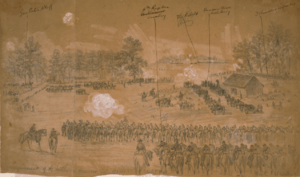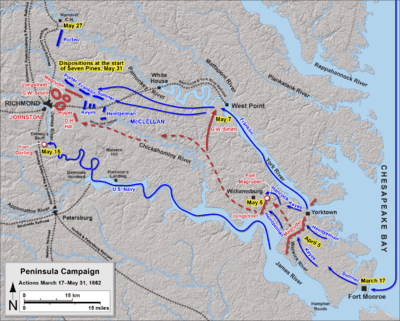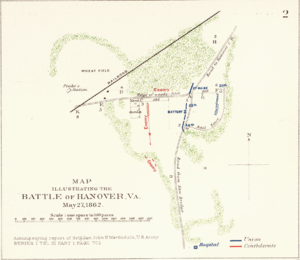Battle of Hanover Court House facts for kids
Quick facts for kids Battle of Hanover Court House |
|||||||
|---|---|---|---|---|---|---|---|
| Part of the American Civil War | |||||||
 Commencement of the battle of Hanover Ct. House. 1:45 PM. Alfred R. Waud, artist, May 27, 1862. |
|||||||
|
|||||||
| Belligerents | |||||||
| Commanders and leaders | |||||||
| Fitz John Porter | Lawrence O'Bryan Branch | ||||||
| Strength | |||||||
| 12,000 | 4,000 | ||||||
| Casualties and losses | |||||||
| 355–397 | 930 | ||||||
The Battle of Hanover Court House, also called the Battle of Slash Church, happened on May 27, 1862. It was fought in Hanover County, Virginia, during the American Civil War. This battle was part of a bigger plan called the Peninsula Campaign.
During this battle, soldiers from the Union Army (the North) fought against soldiers from the Confederate Army (the South). The Union forces were led by Fitz John Porter. Their goal was to protect their army's side and clear the way for more Union soldiers to arrive. The Confederate soldiers were led by Colonel Lawrence O'Bryan Branch. Even though the Union army won, the extra soldiers they were waiting for never came.
Why the Battle Happened
In 1862, Confederate General Joseph E. Johnston moved his army of about 60,000 soldiers away from the Virginia Peninsula. This was because George B. McClellan's Union army was chasing them. Johnston's army set up defenses near Richmond, the Confederate capital. They used the Chickahominy River as a natural barrier.
Johnston's men burned most of the bridges over the river. They took strong positions north and east of Richmond. McClellan's Union army, with about 105,000 soldiers, focused on the northeast area. He wanted to use the Pamunkey River to get supplies. He also expected more Union soldiers to arrive from Fredericksburg. He needed to keep their path safe.
The Union army slowly moved up the Pamunkey River. They set up supply bases along the way. One important base was at White House, a plantation owned by William Henry Fitzhugh Lee. This became McClellan's main base. He used the Richmond and York River Railroad to bring heavy cannons closer to Richmond.
McClellan moved slowly because he thought the Confederates had many more soldiers than they actually did. By the end of May, his army had built bridges over the Chickahominy River. His army was now facing Richmond, but it was split by the river. One-third of his army was south of the river, and two-thirds were north. This made it hard for them to help each other quickly.
While small fights happened along the front lines, McClellan heard a rumor. A civilian told him that 17,000 Confederate soldiers were moving to Hanover Court House. This was north of Mechanicsville. If true, it would threaten the Union army's right side. It would also make it harder for the expected reinforcements to arrive.
A Union cavalry patrol checked the rumor. They found that the enemy force was actually about 6,000 soldiers. This was still a concern for McClellan. So, he ordered his friend, Fitz John Porter, to deal with this threat. Porter commanded the new V Corps.
Porter started his mission early on May 27. He had about 12,000 soldiers. The Confederate force, led by Colonel Lawrence O'Bryan Branch, had about 4,000 men. They were guarding the Virginia Central Railroad near Peake's Crossing. Another Confederate group was about 10 miles north.
The Battle Begins
Porter's soldiers marched towards Peake's Crossing in heavy rain. Around noon on May 27, the first Union soldiers met Confederate troops. These Confederates were on a patrol at Dr. Thomas H. Kinney's farm. The Union soldiers fought them until Porter's main army arrived. The Confederates, who were outnumbered, were pushed back towards the courthouse.
Porter chased them with most of his soldiers. He left three regiments behind to guard an important intersection. These regiments were led by John H. Martindale. This move left the back of Porter's army open to attack. Porter thought the main Confederate force was at Hanover Court House, but he was wrong.
Colonel Branch, the Confederate leader, also made a mistake. He thought Porter's army was much smaller than it was. So, he decided to attack. Colonel Charles C. Lee led his regiment, the 37th North Carolina, along with the 18th North Carolina and two cannons.
The 18th North Carolina attacked first but was pushed back. When the 37th North Carolina joined the fight, Martindale's Union force was almost destroyed. The 44th New York regiment lost a quarter of its soldiers. Their battle flag was hit by 44 bullets!
When Porter heard about the fight, he quickly sent more soldiers back to Kinney Farm. The Confederate line broke when thousands of new Union troops arrived. They retreated back through Peake's Crossing to Ashland.
What Happened After
General McClellan called the Battle of Hanover Court House a "glorious victory." He said it was "one of the handsomest things of the war." In reality, the Union army won because they had more soldiers. Both sides made mistakes during the disorganized fight.
The Union army's right side was now safe. However, the Confederates at Peake's Crossing hadn't really planned to attack it. Also, the extra Union soldiers that McClellan was waiting for never arrived. This was because Union forces were defeated at the First Battle of Winchester by Stonewall Jackson. President Abraham Lincoln then ordered those soldiers to stay in Fredericksburg.
The Union army had about 355 to 397 soldiers killed, wounded, or captured. The Confederates left 200 dead or wounded on the field. Porter's cavalry captured 730 Confederate soldiers.
Historian Stephen W. Sears said the battle had a bigger impact than just the casualties. It affected McClellan's readiness for the next big battle. This was the Battle of Seven Pines and Fair Oaks, which happened four days later. While Porter was away, McClellan was hesitant to move more of his troops south of the Chickahominy River. This made his left side an easier target for Johnston's army.
See also
 In Spanish: Batalla de Hanover Court House para niños
In Spanish: Batalla de Hanover Court House para niños




